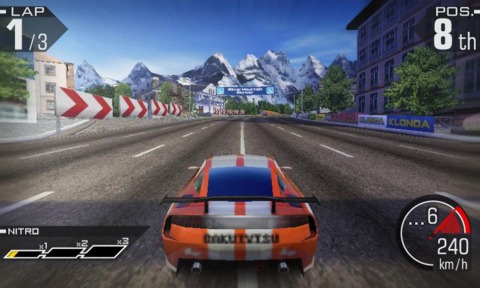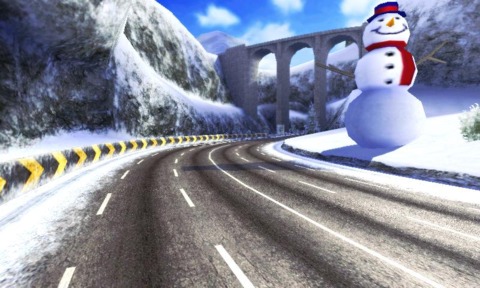
The primary way to progress through Ridge Racer 3D is its Grand Prix mode, which presents you with a collection of events, each with its own set of races. It's pretty standard, and as you work your way through, you'll unlock new cars and advance into new categories, which gives you a faster class of cars to choose from. There are a lot of events in the Grand Prix mode, but it isn't supported by enough tracks to make working your way through the events interesting. By the second or third event, the game is already throwing tracks that you've already raced on into the mix. In fact, the game opens with the track from the very first Ridge Racer game, an inclusion that you'll either take as terrific nostalgia or a sign that the game is way too derivative, since this isn't the first time that the franchise has relied on old tracks in new games. The races go up to eight cars in all, which is a lower number than the series has handled in the past, even on portable platforms.
In addition to the Grand Prix, you can set up single races, time attacks, and other one-off events, though most of these don't give you any points, which is the currency you'll use to unlock additional cars and nitrous upgrades. Considering how many times you'll be repeating the same tracks in the standard Grand Prix, setting up even more races on those same tracks without getting anything for it seems like a waste of time unless you're really into setting lap times or if you're lucky enough to be near other Ridge Racer 3D players so you can exchange lap times and ghost data via the built-in StreetPass feature on the 3DS.

The new drift button sort of takes the skill out of playing Ridge Racer, but I don't know that it makes the concepts behind Ridge Racer's driving model any easier to understand. If you haven't already experienced the series, but have been playing a lot of other driving games over the years, I imagine that the game will feel like it was designed by folks who have never driven an actual car. But if you can eradicate any desire for realism from your head, taking the corners in a Ridge Racer game is still pretty entertaining, if only to see how hard you can push cars into the turn and still come out unscathed. Let's call it an acquired taste that's only become tougher to acquire as the driving genre has grown in popularity and diversity over the past 16 years.
The 3D effect in Ridge Racer 3D can be a bit extreme. I had no trouble playing it in the first-person view, but when you play from the default behind-the-car perspective, I found that the car sticks out a bit too much, making it hard to focus on the turns ahead. I solved this problem by turning the 3D down to around the halfway mark, but this is more of a personal taste thing, so you'll probably have a different experience. The game's frame rate isn't as smooth as it has been in past Ridge Racer releases, but it's stable and conveys a decent sense of speed.
If playing a new Ridge Racer game at the launch of every platform has become part of your routine, Ridge Racer 3D fills a security blanket-like role of letting you know that Namco is still making Ridge Racer games the same way its been making them since nitrous was added back at the launch of the PSP. But if you expect forward movement and new ideas from sequels, it's hard not to look at Ridge Racer 3D as a stubborn relic from a bygone era.